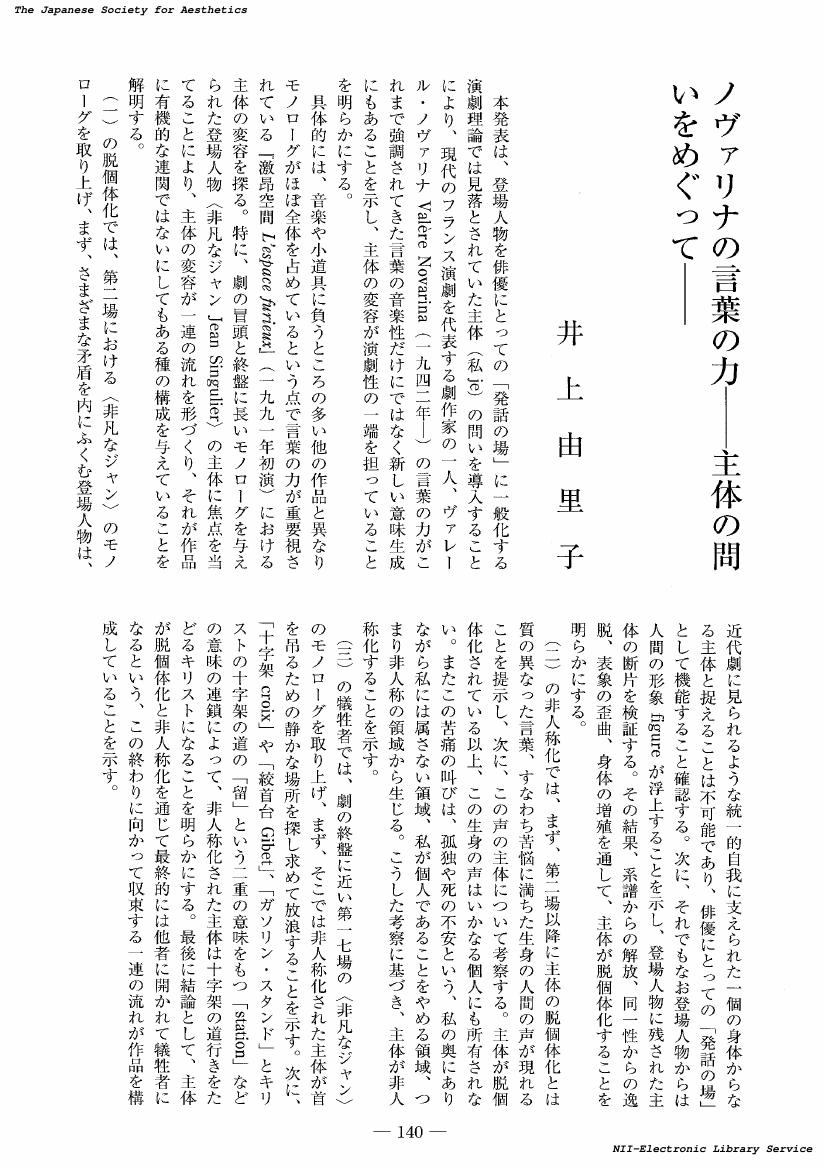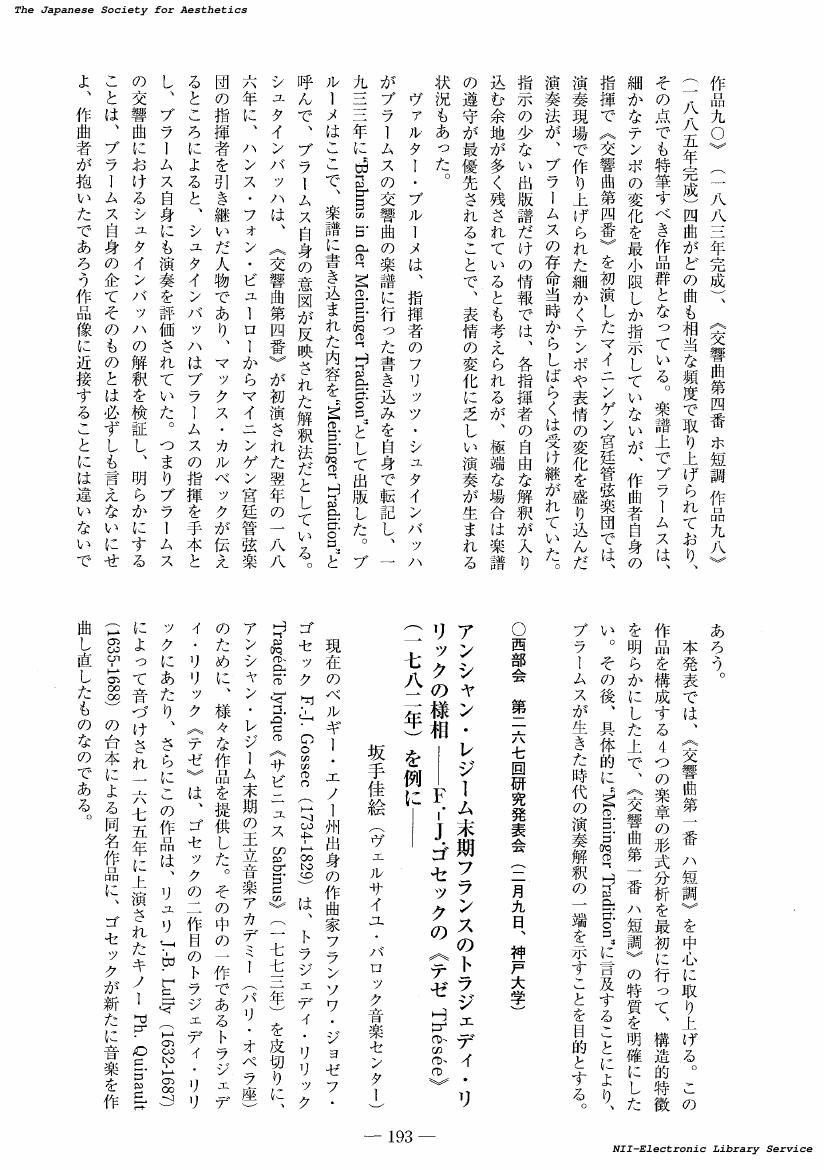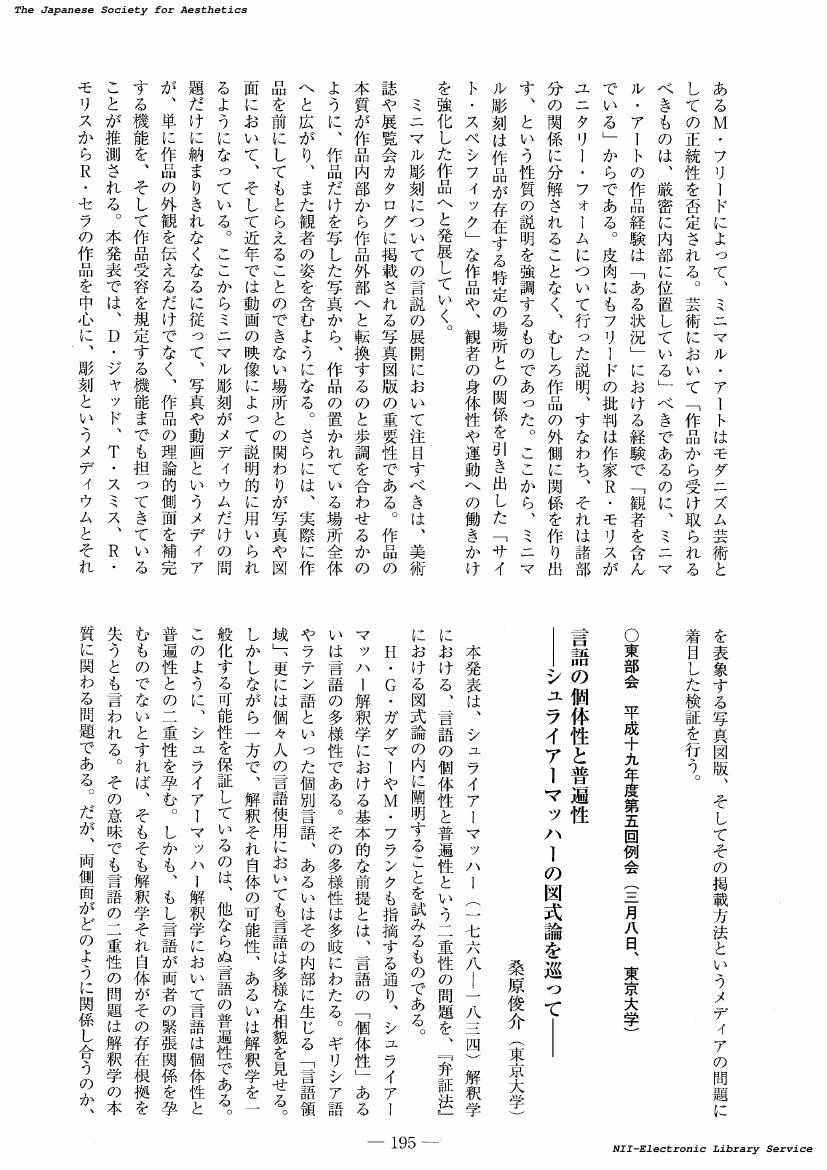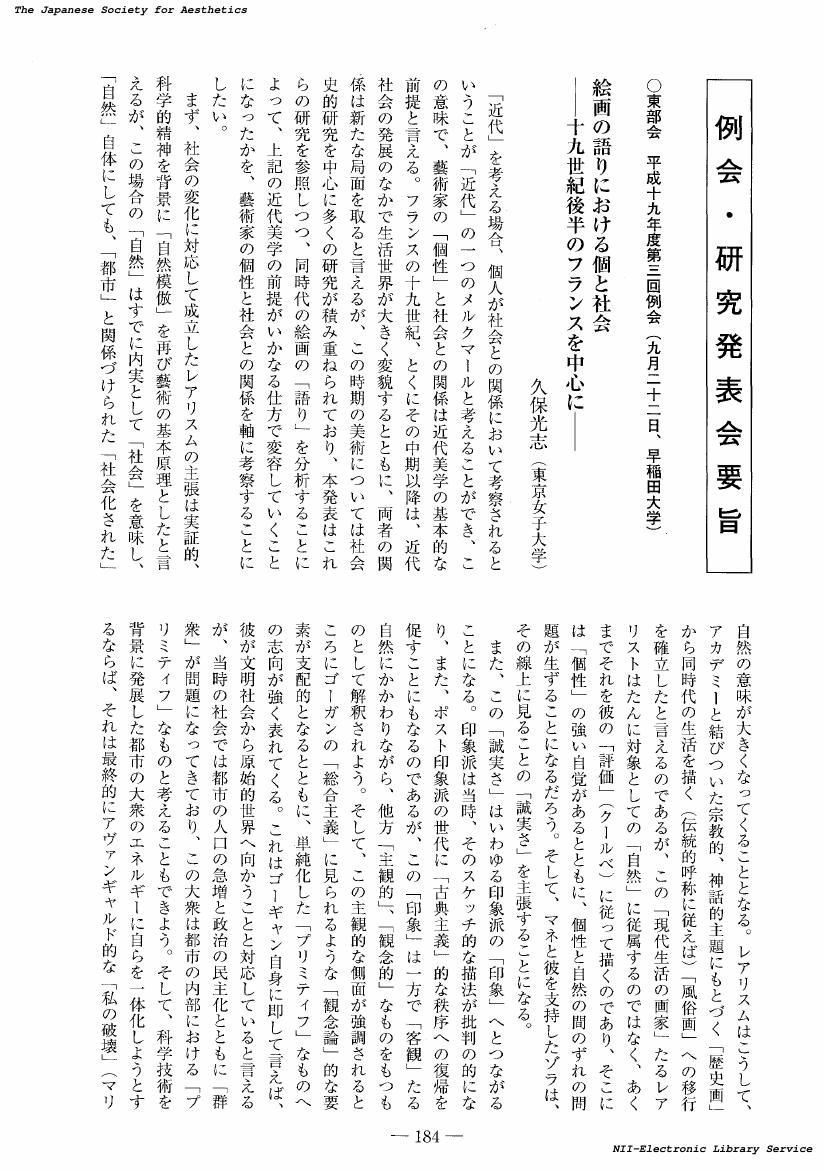1 0 0 0 OA ノヴァリナの言葉の力 : 主体の問いをめぐって(第五十九回美学会全国大会発表要旨)
- 著者
- 井上 由里子
- 出版者
- 美学会
- 雑誌
- 美学 (ISSN:05200962)
- 巻号頁・発行日
- vol.59, no.2, pp.140, 2008-12-31 (Released:2017-05-22)
- 著者
- 平山 敬二
- 出版者
- 美学会
- 雑誌
- 美学 (ISSN:05200962)
- 巻号頁・発行日
- vol.59, no.1, pp.196-197, 2008-06-30 (Released:2017-05-22)
1 0 0 0 OA T・E・ヒュームの芸術論と原(プロト)ファシズム・イデオロギー
- 著者
- 石田 圭子
- 出版者
- 美学会
- 雑誌
- 美学 (ISSN:05200962)
- 巻号頁・発行日
- vol.59, no.2, pp.2-15, 2008-12-31 (Released:2017-05-22)
T. E. Hulme, an aesthetician and a critic, is famous for his contribution to Imagism, one of the most important movements of Anglo-American Modernism. This leading figure of Modernism is also notorious as a sympathizer of protofascism who celebrates Charles Maurras and Georges Sorel. In this paper, I try to analyze the relation between Hulme's aesthetics and the ideology of protofascism. In his essays, rejecting the sensibility of Romanticism, Hulme insists on the superiority of Classicism, which is, actually, deeply affected by the political and literary view of Maurras who regards Classicism as 'anti' to liberalism and democracy. Moreover his keen interest in geometric-abstract art reflects his worldview - reactionary modernism whose core is 'the religious attitude'. In this view, he supports Sorel's political theory in which he finds Classicism and the religious attitude. Finally I point out the homogeneity between Hulme's idea and protofascistic Weltanschauung by taking an overview on the rise of irrationalism and the vulgarized Lebensphilosophie. This close relationship between aesthetics and protofascism in Hulme's thought suggests that Modernism and fascism, the two concepts that are widely assumed to be antithetical, might partly have an profound kinship.
1 0 0 0 OA フーコーにおける「感性論」の可能性 : 「外」との関わりから
- 著者
- 武田 宙也
- 出版者
- 美学会
- 雑誌
- 美学 (ISSN:05200962)
- 巻号頁・発行日
- vol.59, no.2, pp.30-43, 2008-12-31 (Released:2017-05-22)
Cet article se propose d'expliciter le rapport de Michel Foucault a l'esthetique a partir d'un concept du dehors. Qu'est-ce que Foucault entend exactement par <<dehors>>? En reconstituant le jeu que joue ce concept ou en suivant les variations de ce <<dehors>> dans la pensee de ce philosophe, je voudrais formuler une hypothese: que ce concept, qu'il arrache aux textes de Maurice Blanchot dans La pensee du dehors se situe au centre de l'esthetique de Foucault. Une de ces variations, c'est <<l'enonce>> qu'il a propose dans L'archeologie du savoir. C'est une unite dans le discours a laquelle il a donne une certaine qualite de<<materialite incorporelle>>, qui est derivee du stoisisme ou la subjectivite est structuree selon un mode different de celui de la conscience. On peut entendre ici la resonance de <<l'autre dans le Meme>>, ce que Emmanuel Levinas a evoque dans son oeuvre. On voit egalement le dernier theme que Foucault s'est efforce a rechercher: la vie comme oeuvre d'art. Il a pense qu'il y a un moment d'une prise de relations avec l'exteriorite dans l'interiorite. Cette recherche conduit finalement a un chiasme de l'esthetique et de l'ethique. Il me semble que son attention sur l'ethique indique l'indifferenciation originaire des deux, que l'esthetique moderne a elimine.
1 0 0 0 OA 融解する表面 : ヘレニズム以前のギリシアにおけるプロソポンの考察
- 著者
- 佐藤 真理恵
- 出版者
- 美学会
- 雑誌
- 美学 (ISSN:05200962)
- 巻号頁・発行日
- vol.59, no.2, pp.44-57, 2008-12-31 (Released:2017-05-22)
A classical Greek noun, prosopon originally means both face and mask. This paper takes advantage of the reason why this term connotes both of them, which seem directly-opposed ideas by our means. Prosopon is consisted of prefix pros and noun ops, and signifies the thing towards etes literally. It is, to sum up, appearance as surface-front, and dislocates structure of binomial confrontation between face and mask. Nevertheless, it is also impossible to disregard the rest of prosopon which is beyond description in just an aspect above-mentioned of it. Because, prosopon which need the others and is given by the exterior, is fated to be read by someone confront, for indeed its character it is open for and exists in the exterior. And, from a point of view of the watching it, these surface prosopon is a field presence and absence crossing. However, in the other side, in the ancient Greek texts, the action that restores its primary mean as appearance has applied to a moment for conquer a fear of death. Anyway, different from a modern concept, prosopon in the ancient Greek is heteronomous, the face that could not but start from the character of surface-front.
- 著者
- 佐々木 千佳
- 出版者
- 美学会
- 雑誌
- 美学 (ISSN:05200962)
- 巻号頁・発行日
- vol.59, no.2, pp.58-71, 2008-12-31 (Released:2017-05-22)
Un noto ritratto virile, oggi conservato alla Biblioteca Trivulziana di Milano su un foglio miniato, ci presenta un' immagine molto originate e simbolica. L'attenzione degli studiosi e stata lungamente ed esclusivamente attratta da problemi stilistici e di attribuzione, nonche dalla questione dell'identita del soggetto rappresentato, ma senza una adeguata considerazione della funzione dell'opera come ritratto dell'autore del testo della pergamena a cui l'immagine e ancorata come un dono. La Fletcher (1991) ha riconosciuto nel ritratto un'opera di Giovanni Bellini, finora ritenuta perduta, appartenente in origine al manoscritto del Istrias di Raffaele Zovenzoni. Sulla base di questa ipotesi da noi condivisa, ci sembra opportuno collocare l'opera sullo sfondo di una specifica e importantissima attivita tecnico-artigianale dell'epoca, quella della produzione e decorazione libraria. Si puo riconoscere nel ritratto l'effigie dell' autore del testo delle odi dell' Istrias, a cui si accompagna in un rapporto intertestuale di simbolicita-individualita determinato dalla finalita della sua destinazione. Il pittore idealizza l'immagine del poeta usando motivi architettonici e attributi tipici della tradizione della decorazione libraria, evocando una presence reelle dello sguardo dell'autore delle odi direttamente rivolto al dedicatario come un sostituto reale del donatore. Proprio questa, a nostro avviso, e la funzione originaria e it significato dell'immagine nel contesto funzionale e nella sua posizione cronologica nella seconda meta del Quattrocento.
1 0 0 0 OA 聖アウグスティヌスの書斎 : カルパッチョ作「スラブ人会」連作をめぐって
- 著者
- 森田 優子
- 出版者
- 美学会
- 雑誌
- 美学 (ISSN:05200962)
- 巻号頁・発行日
- vol.59, no.2, pp.72-85, 2008-12-31 (Released:2017-05-22)
The cycle of Sts. George, Jerome and Tryphon for the Scuola Dalmata was executed by Vittore Carpaccio in ca. 1502-1511. The Vision of St. Augustine of the cycle is based on the apocryphal letters. Compared with the examples of same subject and the representations of the other study, it reveals that this work is different from the traditional iconography. The setting of study and chapel focused on both the contemplative life and the daily work of bishop. It finds also the details which demonstrate a kind of collectionism. These become the factors which remind anyone's portrait. When we concern on this problem, it's important to see it in the patronal context. The production of the cycle has been inspired by the donation of the relic by Paolo Vallaresso, and it's also important to remember that Maffeo Vallaresso is the archbishop of Zara. He is the humanist-ecclesiastic, interested with the art, which recorded in his letters. On considering these factors, the setting of study and art-conscious details, in the contemporary context, so it can say that the St. Augustine's study is intended to allude the intellectual and ecclesiastical figure of Maffeo Vallaresso.
- 著者
- 森田 優子
- 出版者
- 美学会
- 雑誌
- 美学 (ISSN:05200962)
- 巻号頁・発行日
- vol.59, no.1, pp.188, 2008-06-30 (Released:2017-05-22)
- 著者
- 芳賀 京子
- 出版者
- 美学会
- 雑誌
- 美学 (ISSN:05200962)
- 巻号頁・発行日
- vol.59, no.1, pp.189-190, 2008-06-30 (Released:2017-05-22)
- 著者
- 渡辺 裕
- 出版者
- 美学会
- 雑誌
- 美学 (ISSN:05200962)
- 巻号頁・発行日
- vol.59, no.1, pp.190-191, 2008-06-30 (Released:2017-05-22)
- 著者
- 佐藤 真理恵
- 出版者
- 美学会
- 雑誌
- 美学 (ISSN:05200962)
- 巻号頁・発行日
- vol.59, no.1, pp.191-192, 2008-06-30 (Released:2017-05-22)
- 著者
- 小味渕 彦之
- 出版者
- 美学会
- 雑誌
- 美学 (ISSN:05200962)
- 巻号頁・発行日
- vol.59, no.1, pp.192-193, 2008-06-30 (Released:2017-05-22)
1 0 0 0 OA アンシャン・レジーム末期フランスのトラジェディ・リリックの様相 : F.-J.ゴセックの《テゼThesee》(一七八二年)を例に(西部会第二六七回研究発表会,例会・研究発表会要旨)
- 著者
- 坂手 佳絵
- 出版者
- 美学会
- 雑誌
- 美学 (ISSN:05200962)
- 巻号頁・発行日
- vol.59, no.1, pp.193-194, 2008-06-30 (Released:2017-05-22)
- 著者
- 竹中(金) 悠美
- 出版者
- 美学会
- 雑誌
- 美学 (ISSN:05200962)
- 巻号頁・発行日
- vol.59, no.1, pp.194-195, 2008-06-30 (Released:2017-05-22)
- 著者
- 桑原 俊介
- 出版者
- 美学会
- 雑誌
- 美学 (ISSN:05200962)
- 巻号頁・発行日
- vol.59, no.1, pp.195-196, 2008-06-30 (Released:2017-05-22)
1 0 0 0 OA J=S・シャルダンの静物画におけるエスキースの影響
- 著者
- 宮崎 匠
- 出版者
- 美学会
- 雑誌
- 美学 (ISSN:05200962)
- 巻号頁・発行日
- vol.59, no.1, pp.113-126, 2008-06-30 (Released:2017-05-22)
Les natures mortes de Jean-Simeon Chardin (1699-1779) etaient tres admirees au Salon, a la fois pour la facilite de leur execution et pour le refus des details. Et ce alors meme que, jusqu'a cette epoque, presque tous les peintres de natures mortes representaient tous les details de motifs avec le plus grand soin. Le but du present essai est d'eclairer l'influence de l'esquisse, de la premiere pensee du tableau, sur l'execution si particuliere des natures mortes de Chardin. Au XVIIIe siecle un nombre croissant d'amateurs et de connaisseurs entourant Chardin, comme Denis Diderot, admiraient les peintures de genres classees au bas de la hierarchie des genres, et parmi elles les natures mortes de Chardin. En outre, ils les estimaient davantage pour l'execution que pour la valeur des motifs peints. L'analyse d'exemples precis permet de degager des ressemblances entre l'execution des natures mortes par Chardin et celle des esquisses que de plus en plus de contemporains admiraient. Jusqu'a l'epoque ou il commenca a presenter ses natures mortes au Salon, Chardin put prendre conscience de l'importance de l'esquisse, parce qu'il en executai beaucoup, en collectionnait et en parlait meme au Salon.
1 0 0 0 OA イタリア合理主義建築運動における詩学と修辞 : エドアルド・ペルシコと近代の葛藤
- 著者
- 鯖江 秀樹
- 出版者
- 美学会
- 雑誌
- 美学 (ISSN:05200962)
- 巻号頁・発行日
- vol.59, no.1, pp.127-139, 2008-06-30 (Released:2017-05-22)
This paper aims at investigating the peculiar aspects of Italian architectural culture under the fascist regime. Edoardo Persico, the most important critic of architecture between the two wars, recognized well that political powers and architecture crossed on the critical discourse. From this point of view, he defined the short history of this Italian movement as a process from 'europeismo' to 'romanita', and to 'mediterraneita'. These notions do not imply the supremacy of Italian ethic and nation, but demonstrate that young architects, who had been eager to introduce European modern building styles into their own country, was subordinated to political requests of fascism. Yet it was more important for Persico to reveal the rhetorical mechanism that obstructed the European artistic taste ('gusto europeo') and also disguised the Italian one ('gusto italiano') as they were. Hence his analysis of a lot of reviews appeared on the catalogues or magazines proved the diversity of the modern culture. Persico was the only writer that could describe the whole space of critical discourse as a matrix of fascist cultures with some paradoxical characters.
1 0 0 0 OA 「貧しさ」の内と外 : 「アルテ・ポーヴェラ」の領域に関する考察
- 著者
- 池野 絢子
- 出版者
- 美学会
- 雑誌
- 美学 (ISSN:05200962)
- 巻号頁・発行日
- vol.59, no.1, pp.140-153, 2008-06-30 (Released:2017-05-22)
This research is going to talk about the formation of 'Arte povera' as an artistic movement. Today, Arte povera is well-known all over the world as that which used 'poor' materials, such as woods, papers, coals, etc. Although this definition does not always accord with the works in respect of materials and concepts, that critical term 'povera' has succeeded in grouping up the various artists. In fact 'povera' is so ambiguous term that we can do nothing but refer to the text of a critic, Germano Celant, who named this movement. But it can be thought that between the critical discourses and the diverse works, there should be essential difference. Making it clear, this text will study from following three perspectives; the strategy of Celant, contradiction between his rhetoric and acts of artists, and problem with historicization and reception of 'Arte povera.' Through these analyses, it is aimed to show what is included in and what is excluded from the territory of 'Arte povera' along its history.
- 著者
- 小河原 あや
- 出版者
- 美学会
- 雑誌
- 美学 (ISSN:05200962)
- 巻号頁・発行日
- vol.59, no.1, pp.154-166, 2008-06-30 (Released:2017-05-22)
Jean Rouch advocated "cinema-verite" because he considered narrative cinema as the best way to show truth. In his film La Pyramide humaine (1961), some black African students and some white French students at a Cote-d'Ivoire high school improvise according to a general story line in which they make friends with one another. Rouch, following his performers with the camera in his hand, provokes them into action and storytelling. He engages in storytelling as an accomplice. In the classical cinema, characters are in the image, while the camera/director stays outside. Within this framework what the character sees is shown to be equal with what the camera/director sees. According to Deleuze, this not only presents the model of truth but also establishes the identity of the character seen and the one who sees. But in La Pyramide humaine, the camera/director is involved in the image. This precludes the equation, and, consequently, the established truth as well as the identity of characters. In this way, the students become others. "I is another" is a false proposition, but it enables them to tell a story. It has the power to create-to create a truth. Such creativity is what Rouch aimed for in his cinema.
- 著者
- 久保 光志
- 出版者
- 美学会
- 雑誌
- 美学 (ISSN:05200962)
- 巻号頁・発行日
- vol.59, no.1, pp.184-185, 2008-06-30 (Released:2017-05-22)










